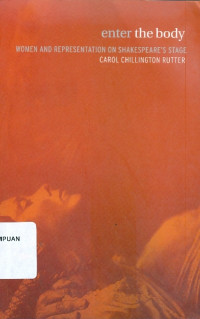
Text
Enter the body: women and representation on Shakespeare's stage
Enter the Body offers a series of provocative case studies of the work women's bodies do on Shakespeare's intensely body-conscious stage. Rutter's topics are sex, death, race, gender, culture, politics, and the excessive performative body that exceeds the playtext it inhabits. As well as drawing upon vital primary documents from Shakespeare's day, Rutter offers close readings of women's performance's on stage and film in Britian today, from Peggy Ashcroft's (white) Cleopatra and Whoopi Goldberg's (whiteface) African Queen to Sally Dexter's languorous Helen and Alan Howard's raver 'Queen' of Troy. Carol Chillington Rutter's book presents case studies of the stage "bodies" of Cordelia, Ophelia, Cleopatra, Cressida, and Emilia examined from multiple insightful angles. Rutter views the body as a discrete template by which we read the events unfolding on stage. She maintains that sociopolitical and cultural precepts have affected production values as well as critical responses to the plays. She demonstrates how ignoring physical presencing on stage can undermine textual comprehension. For each chapter, a single female character provides the focus that anchors an analysis of modern British productions supported by historical references, informative notes, and a useful bibliography. What gives the book life, however, is Rutter's take on theatre as a performative act of re-membering, spiked with her irreverent British wit.
Each chapter deals with the basic relationship between dramatic text and the actor/character's physical presence at the point when the playtext is completed but the body remains present. In the preface Rutter states: "The body in play bears continuous meaning on stage, and always exceeds the playtext it inhabits. My business is to pay attention to that 'excessive' performance text, to register and analyze it" (xiii). Her first chapter, "Body Parts or Parts for Bodies: Speculating on Cordelia" examines Cordelia, dead in the arms of Lear, re-presenting that "play's troubled interests"--as a kind of "memento mori" that bonds characters and audience in "doing grief work" (10). The corpse becomes an instructive object not only as a theatrical text but also as a social text. In the second chapter, "Snatched bodies: Ophelia in the grave," another female corpse serves the author as an example of Shakespeare's subversive dramaturgy. Rutter deems the burial scene (Hamlet 5.1) necessary because "it radically subverts Hamlet's heroic project" (28). She analyzes four Hamlet films (Olivier, 1947; Kozintsev, 1964; Zeffirelli, 1990; Branagh, 1997), demonstrating in each some form of misogynistic, semiotically confused, even illiterate (Branagh) rendering of Ophelia. After a detailed scene analysis, she proffers her own directorial fantasy with the corpse relentlessly present center stage as a realistic drowning victim, the designated onlooker whose lifeless presence mocks all heroic pretensions. Both chapters contend that the female corpse in Shakespeare presents death as a gendered site where a culture reveals its real thinking about women.
The third chapter, "Shadowing Cleopatra: Making Whiteness Strange" presents a potent case for a black Cleopatra by pointing out that Shakespeare himself "wrote a black narrative at the centre of Antony and Cleopatra"(62). This chapter reveals Rutter's prevalent interest in gender and race politics as played out on stage. Her knowledge of historical sources and criticism in early modern and Shakespeare studies as well as her close scrutiny of four representative British production photographs (1953, 1972, 1982, 1992) support her assertion that a persistent "white" foregrounding has marginalized the actual Shakespearean black narrative. Rutter relates Shakepeare's black casting of Cleopatra to the 1604 production of The Masque of Blackness devised by Ben Jonson and Inigo Jones for Queen Anne. The queen and ladies-in-waiting, playing the twelve daughters of the River Niger, daubed themselves with black make-up. Shakespeare's play was performed at King James's court in 1606 and 1607. Rutter argues by this juxtaposition that Shakespeare's play had already touched on an emerging cultural conflict between The Western (Britain/Rome) and the "Other" (Egypt/Africa) world; this conflict between a rationalized, intellectual mode and a sexualized, fecund mode would continue, ultimately spawning and fomenting the modern forms of racism. She cites some revealing anecdotes from the RSC's casting practices that kept Cleopatra white under the pretext of authenticity, although her retinue has been cast black.
Availability
| KP.II-00177 | GEN.0.00 RUT e | My Library | Available |
Detail Information
- Series Title
-
-
- Call Number
-
KP.II.RUT e
- Publisher
- London : Routledge., 2001
- Collation
-
xxi, 218 Hal.: ill. ; 22cm.
- Language
-
English
- ISBN/ISSN
-
0-415-141-64-8
- Classification
-
KP.II.
- Content Type
-
-
- Media Type
-
-
- Carrier Type
-
-
- Edition
-
first published 2001
- Subject(s)
- Specific Detail Info
-
-
- Statement of Responsibility
-
-
Other version/related
No other version available
File Attachment
Comments
You must be logged in to post a comment
 Computer Science, Information & General Works
Computer Science, Information & General Works  Philosophy & Psychology
Philosophy & Psychology  Religion
Religion  Social Sciences
Social Sciences  Language
Language  Pure Science
Pure Science  Applied Sciences
Applied Sciences  Art & Recreation
Art & Recreation  Literature
Literature  History & Geography
History & Geography